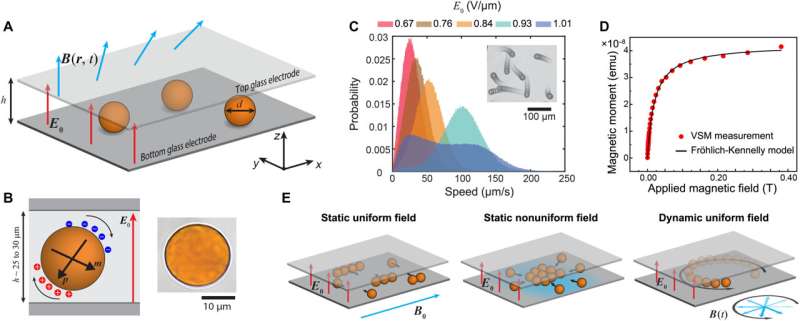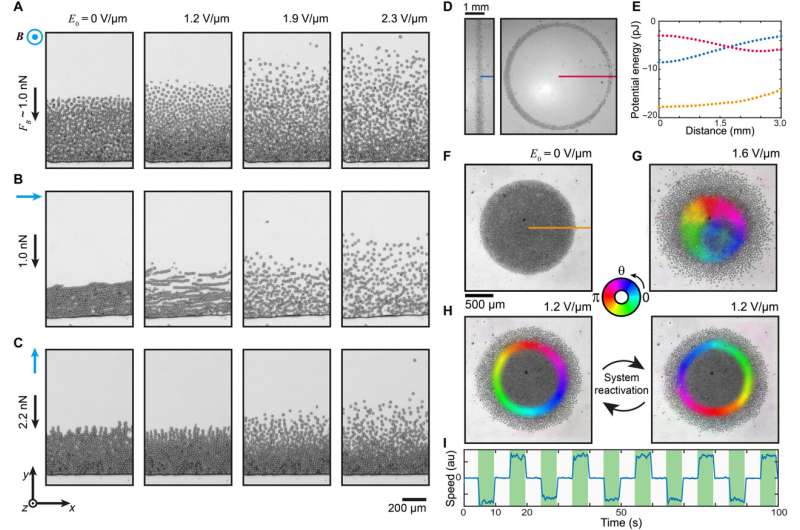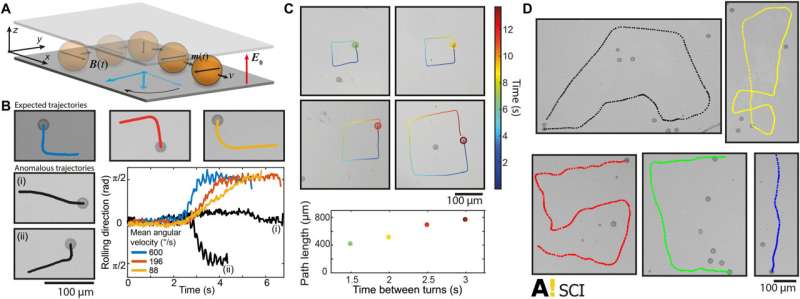July 24, 2023 feature
This article has been reviewed according to Science X's editorial process and policies. Editors have highlighted the following attributes while ensuring the content's credibility:
fact-checked
peer-reviewed publication
trusted source
proofread
Magnetic Quincke rollers: Forces and torques of magnetism that guide complex dynamics of active particles

Quincke rotation is defined as the spontaneous steady rotation of a dielectric particle immersed in a dielectric solvent under a steady and uniform electric field. Electro-hydrodynamically driven active particles based on Quincke rotation are a significant model system for emergent collective behavior in non-equilibrium colloidal systems. Quincke rollers are intrinsically nonmagnetic and therefore magnetic fields cannot be used to regulate their complex dynamics.
In a new report published in Science Advances, Ricardo Reyes Garza and a research team in applied physics, Aalto University School of Science, Finland, developed magnetic Quincke rollers via silica particles doped with superparamagnetic iron oxide nanoparticles. This magnetic nature allowed the application of external forces and torques that can be regulated at high space-time precision. Applications include tunable interparticle interactions with potential landscapes, and advanced programmable and teleoperated behaviors.
Active matter systems
Active matter systems are based on many individual agents that absorb energy from their environment to convert it to mechanical forces and motion. Recently, researchers have shown increased attention to artificial active systems such as Janus particles, vibrated polar disks and Quincke rollers. Quincke rollers are significant due to their rich, collective dynamics and a range of emergent states observed with solid non-deformable Quincke rollers and deformable liquid droplets. The emergent states include polar liquids, vortices, and active emulsions of liquid rollers.
The dynamics of these states are fast and depend on the same electric field to influence Quincke rotation. Magnetic forces and torques can be applied to successfully regulate the dynamics of soft materials ranging from individual macromolecules to solid particles, and bulk liquids. They can be used to energize systems in the form of oscillating magnetic fields, to steer or activate passive particles.
Experimental outcomes
This work detailed the development of broadly tunable Quincke rollers by using magnetic forces and torques. The system contained spherical silicon dioxide particles doped with superparamagnetic iron oxide nanoparticles immersed in a slightly conductive liquid medium, containing n-dodecane with sodium bis (2-ethylhexyl) sulfosuccinate.
The scientists incubated the dispersion in a low-humidity chamber to reduce particle charging and confined it in a quasi-two-dimensional geometry with two transparent parallel plate electrodes. The particles were responsive to external electric and magnetic fields by developing electric and magnetic dipoles. The electric dipole became unstable, as seen with regular non-magnetic Quincke rollers, where the particles started to Quincke rotate when the applied electric field strength exceeded the threshold field.
Magnetic forces
When Garza and colleagues subjected the rollers to a uniform in-plane magnetic field within the Hele-Shaw cell, the rollers maintained a magnetic moment and experienced a torque originating from dipolar interactions with adjacent rollers, and weak magnetic anisotropy within the particles themselves. The net torque drove the particles to align their axes along an external magnetic field, fixing the axis of the Quincke rotation at the same time.
This outcome allowed the alignment of rollers held together with magnetic forces to form a chain. When Garza and colleagues removed the magnetic field, the dipolar forces vanished and the chain returned to individual rollers; highlighting the significance of magnetic forces and their reversibility. The scientists used high-speed imaging to confirm the rotation axes of the particles.
Frequency of rotation
The researchers observed variations of the rotational frequencies and gathered this data by directly following the motion of imperfections on rotating particles. They noted how the particles hovered between electrodes to stabilize the chain, followed by a rare occurrence of anomalous dimers, suggesting that they were not magnetically monodisperse, with potential for complicated anisotropies to support the anomalous dimer state.
The scientists tuned the balance between magnetic and electrohydrodynamic forces to adjust the fraction of participating rollers to form active chains. The active chains further showed chain-level interactions where collisions between the chains led to them fully merging. The researchers widely tuned the magnetic potential energy landscapes of the experiments, which led to the formation of steady-state particle gradients.

Complex potential energy landscapes
The researchers additionally developed complex potential energy landscapes such as a linear trench or a circular racetrack, using slab- and ring-shaped magnetic field sources. When the team induced a quadratic confinement landscape by using an axisymmetric magnet, they observed a highly dense population of rollers that self-assembled into a vortex state.
Magnetic anisotropy further offered the dynamic regulation of rollers to accomplish complex trajectories including square patterns, and assisted the incorporation of teleportation to create trajectories that formed specific words such as "SCI" by combining ideal external guidance and the intrinsic randomness in Quincke rolling.

Outlook
In this way, Ricardo Reyes Garza and colleagues realized magnetic Quincke rollers with rich, dynamic behaviors, which they tuned with magnetic torques and forces to generate active dimer roller distributions. The scientists confined the collective states in potential energy landscapes, rolling patterns, and even teleoperated single-particle dynamics for regulation. Instead of using magnetic forces and torques to drive the system, the researchers used the setup to simply interact with already active particles.
As a result, the magnetic forces and torques formed a powerful regulatory mechanism suited to interrogate and regulate complex dynamics of active systems across diverse fields of applications, such as magnetically tunable electro-hydrodynamics, colloidal self-assembly, and microrobotics.
More information: Ricardo Reyes Garza et al, Magnetic Quincke rollers with tunable single-particle dynamics and collective states, Science Advances (2023). DOI: 10.1126/sciadv.adh2522
Antoine Bricard et al, Emergence of macroscopic directed motion in populations of motile colloids, Nature (2013). DOI: 10.1038/nature12673
Journal information: Science Advances , Nature
© 2023 Science X Network





















